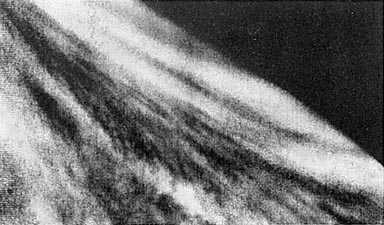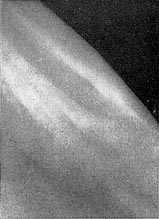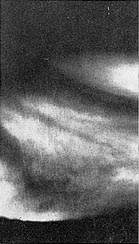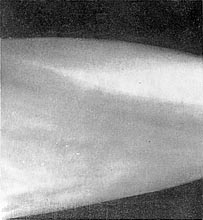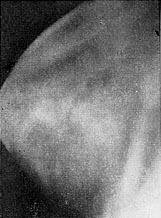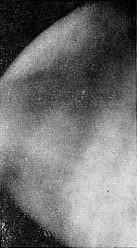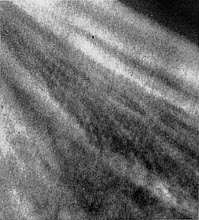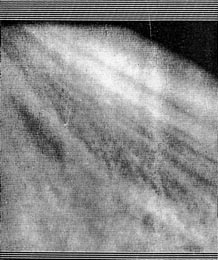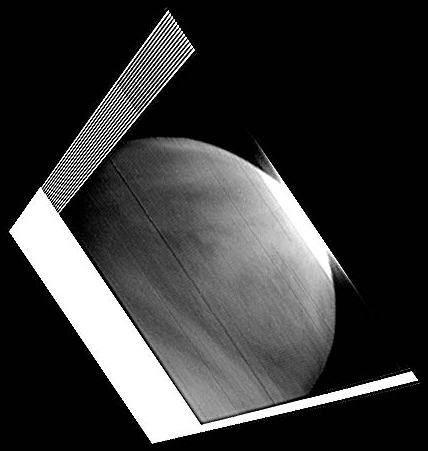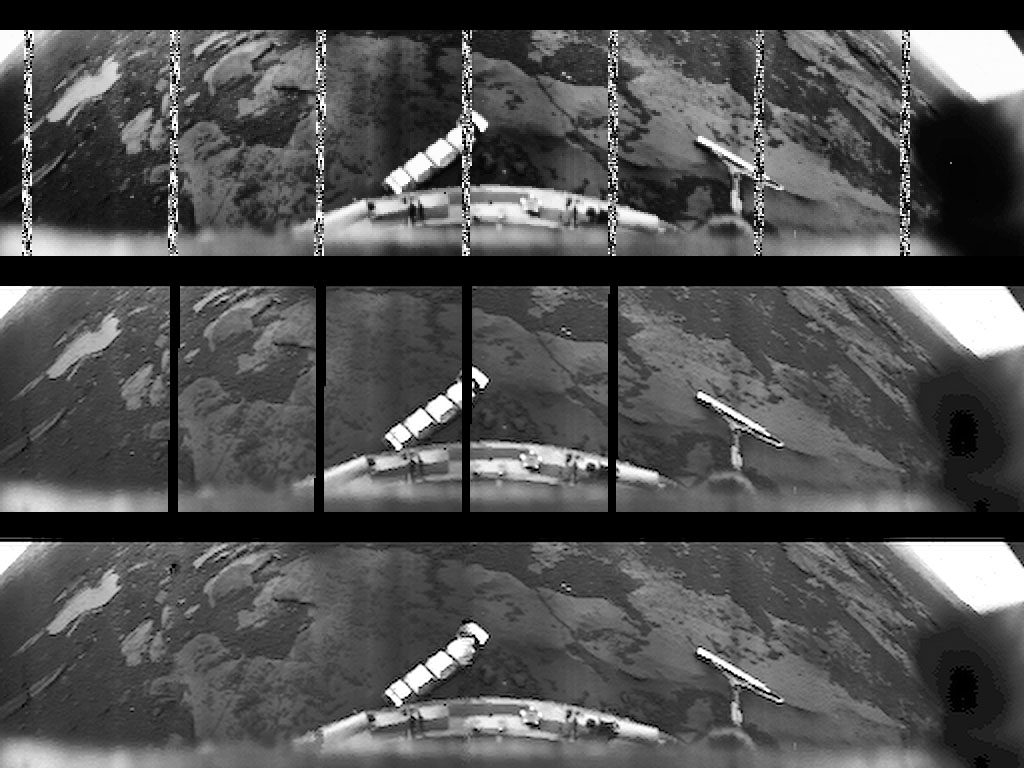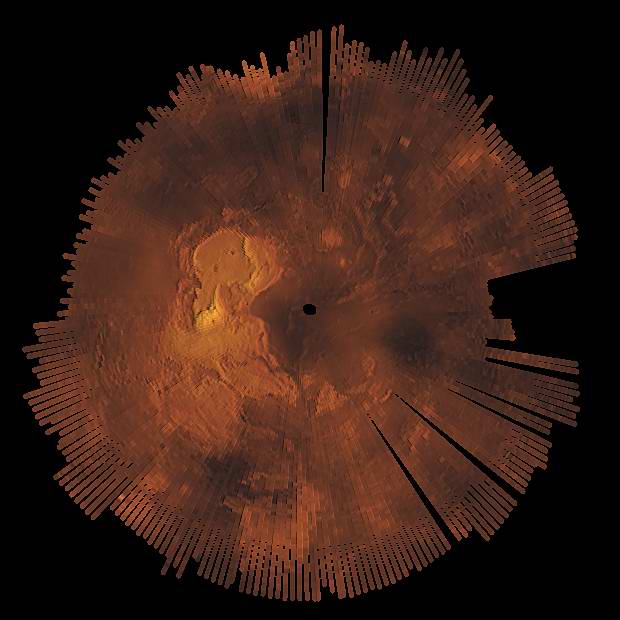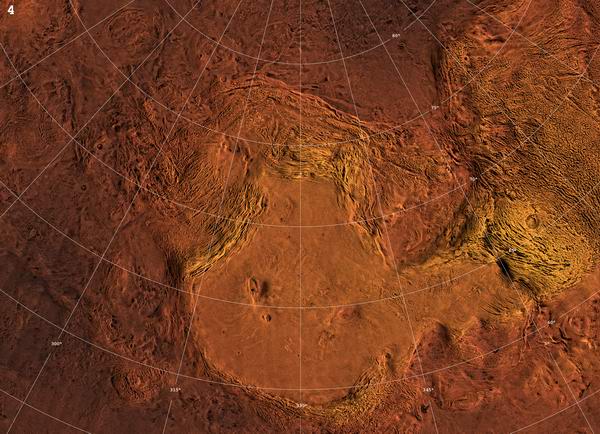Soviet Venus Images

Most of what we know about Venus is derived from the intensive Soviet study of the planet. The only existing images from the surface were returned from four of their landing craft. Attempts to carry phototelevision cameras to Venus in 1962 and 1965 failed, but the Venera-9 orbiter performed the first long-term imaging survey of cloud circulation, in 1975.
Venera-9
Venera-9 was the first lander to photograph the surface of Venus, on October 20, 1975. An optical-mechanical camera, scanning back and forth, returned almost two panoramas of a rocky hillside. The camera system was developed by A.S. Selivanov's team at the Institute of Space Device Engineering. A second camera, facing the opposite side, malfunctioned when atmospheric pressure prevented the ejection of its lens cap.
A digital video signal was transmitted from the lander to the orbiting main spacecraft and recorded on tape. It consisted of 6 bits per pixel (plus a 7th parity bit) encoding a logarithmic brightness value. Each scanline consists of 128 pixels, 11 of which are calibration and synchronization sent during the return stroke of the scanner. This was relayed in real time and retransmitted a few times from the tape recording. The complete video transmission seen below is reconstructed from digital data and photographic records. After completing one panorama, the scanner reversed its motion, generating a second partial panorama, which appears upside down:
 Complete Panoramic Transmission From Venera-9
Complete Panoramic Transmission From Venera-9

Section of Raw Video (Including Sync)
Some of the raw digital data from Venera-9 was found on a tapes exchanged between the Soviet Union and Brown University. It includes the first full panoramic sweep with periodic telemetry bursts, and a second version in which some telemetry bursts have been replaced with sections of the second panorama.
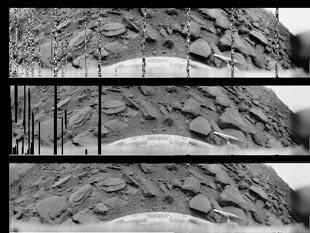
Processed Venera-9 Panorama
The upper image is the raw 6-bit data. The center images include the telemetry brust replacements, with remaining bursts blacked out. The 6-bit values have been transformed to linear brightness, using the published photometric function of the camera, and then converted to sRGB standard form (gamma 2.2). In the final version, I filled in missing regions, using Bertalmio's inpainting algorithm.

Most of what we know about Venus is derived from the intensive Soviet study of the planet. The only existing images from the surface were returned from four of their landing craft. Attempts to carry phototelevision cameras to Venus in 1962 and 1965 failed, but the Venera-9 orbiter performed the first long-term imaging survey of cloud circulation, in 1975.
Venera-9
Venera-9 was the first lander to photograph the surface of Venus, on October 20, 1975. An optical-mechanical camera, scanning back and forth, returned almost two panoramas of a rocky hillside. The camera system was developed by A.S. Selivanov's team at the Institute of Space Device Engineering. A second camera, facing the opposite side, malfunctioned when atmospheric pressure prevented the ejection of its lens cap.
A digital video signal was transmitted from the lander to the orbiting main spacecraft and recorded on tape. It consisted of 6 bits per pixel (plus a 7th parity bit) encoding a logarithmic brightness value. Each scanline consists of 128 pixels, 11 of which are calibration and synchronization sent during the return stroke of the scanner. This was relayed in real time and retransmitted a few times from the tape recording. The complete video transmission seen below is reconstructed from digital data and photographic records. After completing one panorama, the scanner reversed its motion, generating a second partial panorama, which appears upside down:
 Complete Panoramic Transmission From Venera-9
Complete Panoramic Transmission From Venera-9
Section of Raw Video (Including Sync)
Some of the raw digital data from Venera-9 was found on a tapes exchanged between the Soviet Union and Brown University. It includes the first full panoramic sweep with periodic telemetry bursts, and a second version in which some telemetry bursts have been replaced with sections of the second panorama.

Processed Venera-9 Panorama
The upper image is the raw 6-bit data. The center images include the telemetry brust replacements, with remaining bursts blacked out. The 6-bit values have been transformed to linear brightness, using the published photometric function of the camera, and then converted to sRGB standard form (gamma 2.2). In the final version, I filled in missing regions, using Bertalmio's inpainting algorithm.
